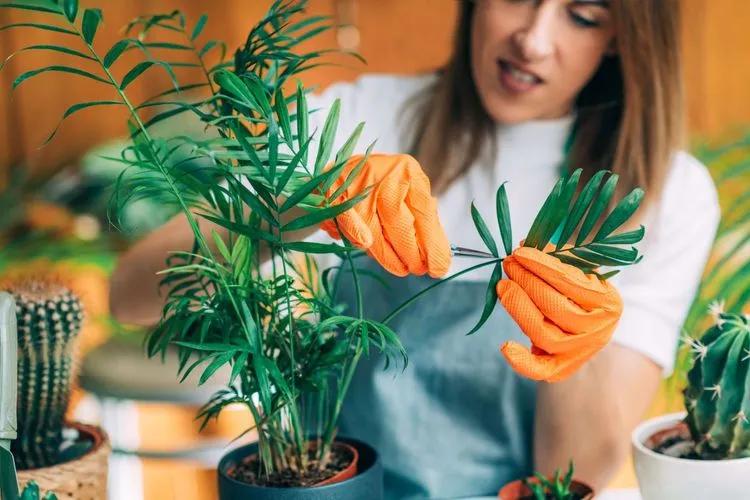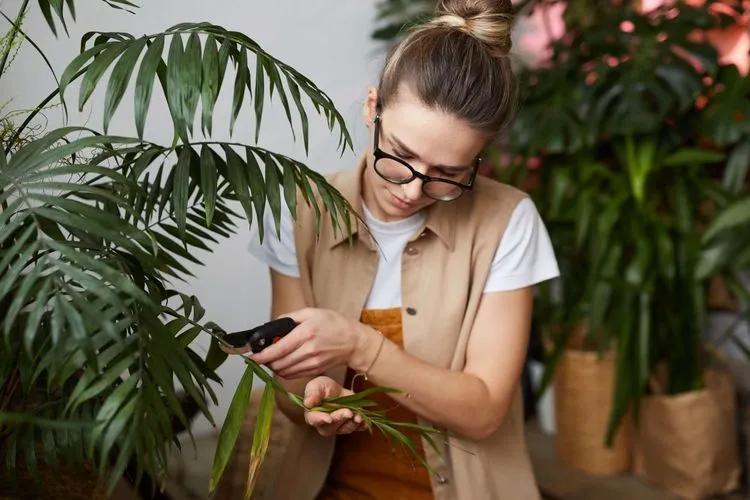 Sooner or later, any lover of indoor flowers faces the need of plant cropping. How to do it correctly so as not to harm your green pet? Read a detailed overview of the types, lifehacks, and methods of plant cutting.
Sooner or later, any lover of indoor flowers faces the need of plant cropping. How to do it correctly so as not to harm your green pet? Read a detailed overview of the types, lifehacks, and methods of plant cutting.
Why cut a plant?
Many people underestimate the need for plant cutting. Although, this procedure is very useful for both outdoor and indoor plants.
1.Sanitary pruning. This type gives green pets a fresh look and eliminates the risk of diseases. Old and yellowed leaves are removed, leaving only new shoots. Sanitary pruning helps to remove the growing shoots of the crown or those that turned out to be very weak and dried up inside. The entire area of damage is trimmed, only healthy tissue remains, and all dry fallen leaves are removed.
-
Pinching young shoots. It carries an aesthetic idea and helps flowers create new shoots.This can give your plant an interesting shape. We recommend carrying this out during very active growth - thus you can cut off the buds at the tops of the shoots, while stimulating the formation of new and fresh shoots.Too long branches can be avoided by giving growth to lateral branches.
-
Rejuvenating. Here, the name speaks for itself. It is best done after winter, when the plant needs growth and full recovery. Start this type of pruning only if you notice that the plant has lost its shape, grows poorly or does not tend to quickly shed its foliage. You can return vitality to your favorite flower, which will delight you with its appearance. Such a pruning type is especially needed for the plants that are prone to frequent shedding of the lower leaf layers or to pulling out shoots. Without this procedure, their life span may be short. Therefore, if you want to enjoy the flower as far as possible, you’d better regularly rejuvenate it.
-
Formation of the crown. Open up space for creativity and create a unique silhouette of your indoor flower. Spring is best suited for this procedure, since this is a time of active growth, and so it is necessary to carry out a sanitary one before it, removing old and yellowed leaves. The formation will stimulate the density of the leaves, exclude stretching and poorly leafed branches.
Preparing for pruning
Before tackling sharp tools, you need to carefully study the intricacies of pruning each plant. Of course, there are generally accepted rules, but some tips may not be suitable for a specific plant, since some do not even tolerate pinching. Read a guide for your flower, examine it carefully - perhaps, it is not high time for pruning. It is worth making the procedure regular so as not to bring the plant to a deplorable state, when it is already half dry or overgrown. Sanitation is usually carried out once a year, during the growth period. Such routine helps plants stay clean throughout the year; it can also be combined with rejuvenation.
Tools
 Use a sharp knife for particularly juicy or small shoots (give preference to special garden knives - they have a better shape for this). If the cut is supposed to be very thin and delicate, you need to take a scalpel into the weapon. Any tools that are not intended for this or with a very blunt blade can be very harmful to the plant.
While pinching, use small scissors. Don’t forget to disinfect the instrument before each cut!
Use a sharp knife for particularly juicy or small shoots (give preference to special garden knives - they have a better shape for this). If the cut is supposed to be very thin and delicate, you need to take a scalpel into the weapon. Any tools that are not intended for this or with a very blunt blade can be very harmful to the plant.
While pinching, use small scissors. Don’t forget to disinfect the instrument before each cut!
Rules of cutting
After disinfecting the tools and surface, wear gloves for personal protection. Also, do not combine cutting with transplantation - it will cause double stress to a plant.
1.Cut only at an angle. It is at an angle and above the buds that will ensure accuracy and it will hardly be possible to make a mistake. For partial trimming, you need to trim, leaving about 3-7 millimeters above the bud. It is necessary to trace where the bud is directed as this can help correct the direction of the crown.
-
Intermediate result. Stop in the process of working to evaluate your creation to correct minor bugs immediately. This will prevent “bare” spots or symmetry.
-
Treatment of wounds. Any cut is a wound for a plant, so you need to process and disinfect it, especially if the shoot is very large. For such occasions, balms and powders for processing slices on garden and greenhouse plants, charcoal (crushed) or sulfur are the perfect supplies. Use these preparations over the entire wounded area of a plant. If it leaves too much juice during cutting, you need to wait until it dries up.
Avoiding common mistakes
 1.If you see unopened buds, do not prune them.
1.If you see unopened buds, do not prune them.
-
Do not cut off leaves and branches that look healthy, unless they show visible signs of illness.
-
If you see knotty formations on the stems, do not cut them. These are just the beginnings of new buds.
-
Use only a well-sharpened tool. Pruning is stressful for plants - an unsharpened instrument will cause even more harm to them.
Care after pruning
After your plant has experienced such manipulations, it needs rehabilitation. Create favorable conditions for its thriving. We recommend you remove the plant from the windowsill to avoid direct sunlight. Check the water routine of the flower carefully - everything should be done in moderation. Take care of air quality and indoor temperature. Remember - successful trimming of your plant does not require more than a pair of sharp scissors and your desire to learn.
